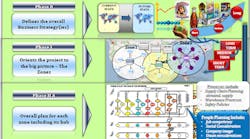Ten Top Supply Chain Mistakes when Entering Emerging Markets—And How to Avoid Them
Very few companies are successful in establishing a global customer footprint. Even fewer are making profits in these markets.
Here are the 10 key reasons why.
Companies:
-
Apply a similar business model in an emerging market that made them successful in a matured market.
-
Charge customers based on cost plus model instead of pricing according to what the market is willing to pay, and offer products in sizes/quantities not aligned with consumer buying patterns.
-
Use the go-to-market strategies that served them well in matured markets, disregarding emerging market differences.
-
Resort to over-sophisticated or under-sophisticated supply chain planning and execution that does not work in specific markets.
-
Establish an infrastructure that is either overly capacitated or under capacitated to meet price and service requirements of consumers.
-
Lack an understanding of the societal, regulatory, taxation, labor / trade union laws, transportation systems, cultural differences and government stability.
-
Key capabilities that should be managed internally and those that should be outsourced and how to measure their effectiveness.
-
Do not establish criteria to differentiate between seasonal and launch growth versus organic growth and how to adapt the supply chain to different growth patterns.
-
Try to apply the same distribution method and go-to-market strategy to every market instead of implementing a localized, personalized and customized service and delivery model.
- Have not integrated all aspects of the supply chain – infrastructure, process, people -- into a cohesive master plan together to arrive at the best generated that can be adapted to changing market needs.
In summary, most companies entering emerging markets to not have a plan to manage the supply chain to grow their top line and generate profits. They try to use the strategies that have worked in mature markets. This approach is doomed to failure.
In this downloadable article, we present a systematic process to solve the dilemma of inadequate thinking in developing a master plan for the supply chain in emerging markets. The planning methodology is based on developing a foundation for the supply chain, with specifics for each step. Thus, supply chain executives will have a road map to use for the master plan that can also be applied to a specific project.
The article is organized in six phases. We present 10 key considerations for each phase and illustrate the methodology with two key ideas.
Our process is designed for companies that have already decided to enter an emerging market with the next steps to take after the decision has been made.
(ed.note: Since writing this article, Shekar has joined The Walt Disney Co. as Vice President
Business Process and Technology.)
Download the full article, including all six phases and full infographic here!



